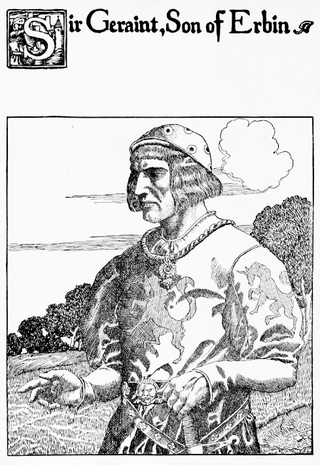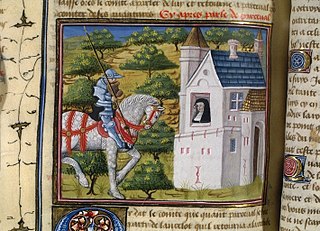
Camelot is a legendary castle and court associated with King Arthur. Absent in the early Arthurian material, Camelot first appeared in 12th-century French romances and, since the Lancelot-Grail cycle, eventually came to be described as the fantastic capital of Arthur's realm and a symbol of the Arthurian world.
In Welsh mythology, Gilfaethwy was a son of the goddess Dôn and brother of Gwydion and Arianrhod in the Fourth Branch of the Mabinogi.

Guinevere, also often written in Modern English as Guenevere or Guenever, was, according to Arthurian legend, an early-medieval queen of Great Britain and the wife of King Arthur. First mentioned in popular literature in the early 12th century, nearly 700 years after the purported times of Arthur, Guinevere has since been portrayed as everything from a fatally flawed, villainous, and opportunistic traitor to a noble and virtuous lady. Many records of the legend also feature the variably recounted story of her abduction and rescue as a major part of the tale.

Chrétien de Troyes was a French poet and trouvère known for his writing on Arthurian subjects such as Gawain, Lancelot, Perceval and the Holy Grail. Chrétien's chivalric romances, including Erec and Enide, Lancelot, Perceval and Yvain, represent some of the best-regarded works of medieval literature. His use of structure, particularly in Yvain, has been seen as a step towards the modern novel.

The Knights of the Round Table are the legendary knights of the fellowship of King Arthur that first appeared in the Matter of Britain literature in the mid-12th century. The Knights are an order dedicated to ensuring the peace of Arthur's kingdom following an early warring period, entrusted in later years to undergo a mystical quest for the Holy Grail. The Round Table at which they meet is a symbol of the equality of its members, who range from sovereign royals to minor nobles.

Percival, alternatively called Peredur, is a figure in the legend of King Arthur, often appearing as one of the Knights of the Round Table. First mentioned by the French author Chrétien de Troyes in the tale Perceval, the Story of the Grail, he is best known for being the original hero in the quest for the Grail before being replaced in later literature by Galahad.

Geraint is a character from Welsh folklore and Arthurian legend, a valiant warrior possibly related to the historical Geraint, an early 8th-century king of Dumnonia. It is also the name of a 6th-century Dumnonian saint king from Briton hagiographies, who may have lived during or shortly prior to the reign of the historical Arthur. The name Geraint is a Welsh form of the Latin Gerontius, meaning "old man".

Perceval, the Story of the Grail is the unfinished fifth verse romance by Chrétien de Troyes, written by him in Old French in the late 12th century. Later authors added 54,000 more lines to the original 9,000 in what are known collectively as the Four Continuations, as well as other related texts. Perceval is the earliest recorded account of what was to become the Quest for the Holy Grail but describes only a golden grail in the central scene, does not call it "holy" and treats a lance, appearing at the same time, as equally significant. Besides the eponymous tale of the grail and the young knight Perceval, the poem and its continuations also tell of the adventures of Gawain and some other knights of King Arthur.

In Arthurian legend, Ywain, also known as Yvain and Owain among other spellings, is a Knight of the Round Table. Tradition often portrays him as the son of King Urien of Gorre and of either the enchantress Modron or the sorceress Morgan le Fay. The historical Owain mab Urien, the basis of the literary character, ruled as the king of Rheged in Britain during the late-6th century.

Erec and Enide is the first of Chrétien de Troyes' five romance poems, completed around 1170. It is one of three completed works by the author. Erec and Enide tells the story of the marriage of the titular characters, as well as the journey they go on to restore Erec's reputation as a knight after he remains inactive for too long. Consisting of about 7000 lines of Old French, the poem is one of the earliest known Arthurian romances in any language, predated only by the Welsh prose narrative Culhwch and Olwen.
The Three Welsh Romances are three Middle Welsh tales associated with the Mabinogion. They are versions of Arthurian tales that also appear in the work of Chrétien de Troyes. Critics have debated whether the Welsh Romances are based on Chrétien's poems or if they derive from a shared original. The Romances survive in the White Book of Rhydderch and the Red Book of Hergest, both from the 14th century, though the material is at least as old as Chrétien.
Geraint son of Erbin is a medieval Welsh poem celebrating the hero Geraint and his deeds at the Battle of Llongborth. The poem consists of three-line englyn stanzas and exists in several versions all in Middle Welsh. The earliest surviving version is in the Black Book of Carmarthen, completed around 1250, though the poem may have been composed in the 10th or 11th century. The poem is significant for its early mention of King Arthur.

Lancelot, the Knight of the Cart, is a 12th-century Old French poem by Chrétien de Troyes, although it is believed that Chrétien did not complete the text himself. It is one of the first stories of the Arthurian legend to feature Lancelot as a prominent character. The narrative tells about the abduction of Queen Guinevere, and is the first text to feature the love affair between Lancelot and Guinevere.
Cligès is a poem by the medieval French poet Chrétien de Troyes, dating from around 1176. It is the second of his five Arthurian romances; Erec and Enide, Cligès, Yvain, Lancelot and Perceval. The poem tells the story of the knight Cligès and his love for his uncle's wife, Fenice.

Lanzelet is a medieval romance written by Ulrich von Zatzikhoven after 1194. It is the first treatment of the Lancelot tradition in German, and contains the earliest known account of the hero's childhood with the Lady of the Lake-like figure in any language. The poem consists of about 9,400 lines arranged in 4-stressed Middle High German couplets. It survives complete in two manuscripts and in fragmentary form in three others.
Bagdemagus, also known as Bademagu, Bademagus, Bademaguz, Bagdemagu, Bagomedés, Baldemagu, Baldemagus, Bandemagu, Bandemagus, Bangdemagew, Baudemagu, Baudemagus, and other variants, is a character in the Arthurian legend, usually depicted as king of the land of Gorre and a Knight of the Round Table. He originally figures in literature the father of the knight Maleagant, who abducts King Arthur's wife Queen Guinevere in several versions of a popular episode. Bagdemagus first appears in French sources, but the character may have developed out of the earlier Welsh traditions of Guinevere's abduction, an evolution suggested by the distinctively otherworldly portrayal of his realm. He is portrayed as a kinsman and ally of Arthur and a wise and virtuous king, despite the actions of his son. In later versions, his connection to Maleagant disappears altogether.

Edern ap Nudd was a knight of the Round Table in Arthur's court in early Arthurian tradition. As the son of Nudd, he is the brother of Gwyn, Creiddylad, and Owain ap Nudd. In French romances, he is sometimes made the king of a separate realm. As St Edern, he has two churches dedicated to him in Wales.

Erec is a Middle High German poem written in rhyming couplets by Hartmann von Aue. It is thought to be the earliest of Hartmann's narrative works and dates from around 1185. An adaptation of Chrétien de Troyes' Erec et Enide, it is the first Arthurian Romance in German.
Guiomar is the best known name of a character appearing in many medieval texts relating to the Arthurian legend, often in relationship with Morgan le Fay or a similar fairy queen type character.
In the Middle High German (MHG) period (1050–1350) the courtly romance, written in rhyming couplets, was the dominant narrative genre in the literature of the noble courts, and the romances of Hartmann von Aue, Gottfried von Strassburg and Wolfram von Eschenbach, written c. 1185 – c. 1210, are recognized as classics.













